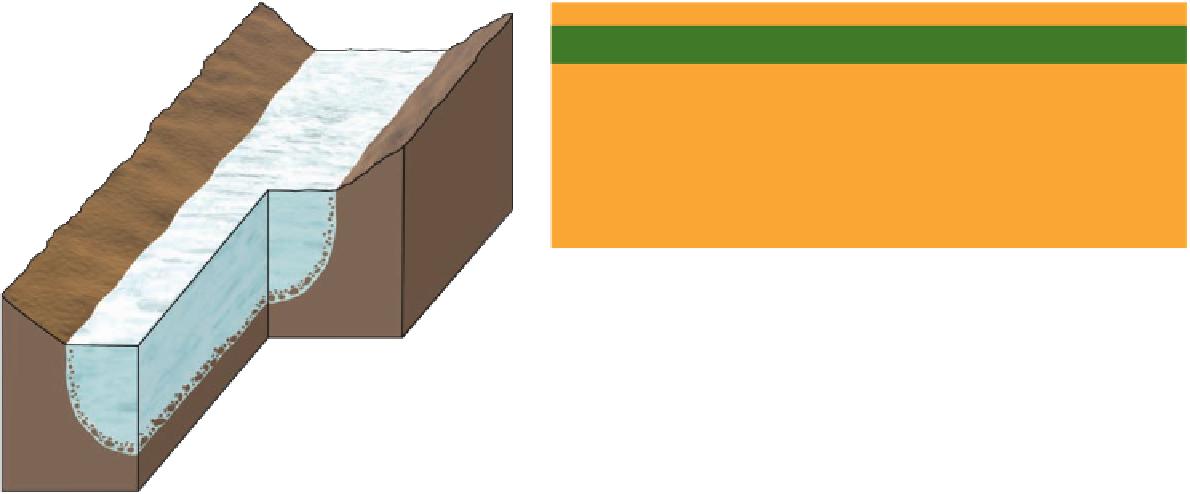Geology Reference
In-Depth Information
?
What Would You Do
After carefully observing the same valley glacier for several
years, you conclude (1) that its terminus has retreated at
least 1 km and (2) that debris on its surface have obviously
moved several hundreds of meters toward the glacier's termi-
nus. Can you think of an explanation for these observations?
Also, why do you think studying glaciers might have some im-
plications for the debate on global warming?
for “rock sheep.” As shown in
Figure 14.9, a glacier
smooths the “upstream” side of an obstacle, such as a small
hill, and plucks pieces of rock from the “downstream”
side by repeatedly freezing to and pulling away from the
obstacle.
Bedrock over which sediment-laden glacial ice moves
is effectively eroded by
abrasion
and develops a
glacial
polish,
a smooth surface that glistens in reflected light
(
◗
◗
Figure 14.8
Flow Velocity in a Valley Glacier Flow velocity in
a valley glacier varies both horizontally and vertically. Velocity is
greatest at the top center of the glacier because friction with the
walls and fl oor of the trough slows the fl ow adjacent to these
boundaries. The lengths of the arrows in the fi gure are proportional
to velocity.
Figure 14.10a). Abrasion also yields
glacial striations,
consisting of rather straight scratches rarely more than
a few millimeters deep on rock surfaces. Abrasion thor-
oughly pulverizes rocks, yielding an aggregate of clay- and
silt-sized particles that have the consistency of flour—
hence, the name
rock flour
. Rock flour is so common in
streams discharging from glaciers that the water has a
milky appearance (Figure 14.10b).
Continental glaciers derive sediment from mountains
projecting through them, and wind-blown dust settles on
their surfaces, but most of their sediment comes from the
surface they move over. As a result, most sediment is trans-
ported in the lower part of the ice sheet. In contrast, valley
glaciers carry sediment in all parts of the ice, but it is con-
centrated at the base and along the margins (
◗
soft sediment beneath a glacier squeezes fl uids through the
sediment, thereby allowing the overlying glacier to slide
more effectively.
BY GLACIERS
As moving solids, glaciers erode, transport, and eventually
deposit huge quantities of sediment and soil. Indeed, they
have the capacity to transport any size of sediment, includ-
ing boulders the size of houses, as well as clay-sized particles.
Important processes of erosion include bulldozing, pluck-
ing, and abrasion.
Although
bulldozing
is not a formal geologic term, it
is fairly self-explanatory; glaciers shove or push unconsoli-
dated materials in their paths. This effective process was aptly
described in 1744 during the Little Ice Age by an observer in
Norway:
Figure 14.11).
Some of the marginal sediment is derived by abrasion and
plucking, but much of it is supplied by mass wasting pro-
cesses, as when soil, sediment, or rock falls or slides onto the
glacier's surface.
◗
When mountain ranges are eroded by valley glaciers, they take
on a unique appearance of angular ridges and peaks in the midst
of broad, smooth valleys with near-vertical walls. The erosional
landforms produced by valley glaciers are easily recognized and
enable us to appreciate the tremendous erosive power of mov-
ing ice. See Geo-inSight on pages 370 and 371 which features
U-shaped glacial troughs, fjords, hanging valleys, cirques, arêtes,
and horns.
U-Shaped Glacial Troughs
A
U-shaped glacial trough
is one of the most distinctive features of valley glaciation.
Mountain valleys eroded by running water are typically
V-shaped in cross section; that is, they have valley walls that
descend to a narrow valley bottom (
When at times [the glacier] pushes forward a great
sound is heard, like that of an organ and it pushes
in front of it unmeasurable masses of soil, grit and
rocks bigger than any house could be, which it then
crushes small like sand.*
Plucking
, also called
quarrying
, results when glacial ice
freezes in the cracks and crevices of a bedrock projection
and eventually pulls it loose. One manifestation of pluck-
ing is a landform called a
roche moutonnée
, a French term
Figure 14.12a). In con-
trast, valleys scoured by glaciers are deepened, widened, and
straightened so that they have very steep or vertical walls, but
◗
*Quoted in C. Offi cer and J. Page,
Tales of the Earth
(New York: Oxford
University Press, 1993), p. 99.






Search WWH ::

Custom Search